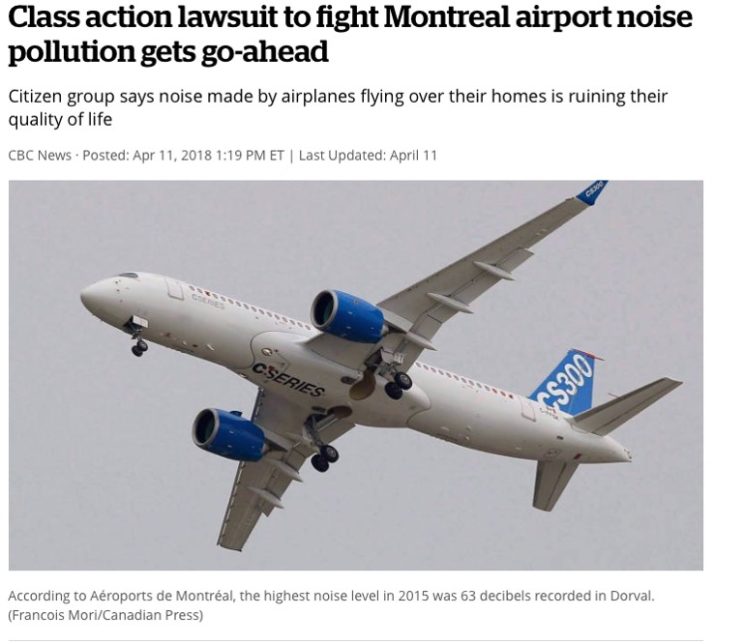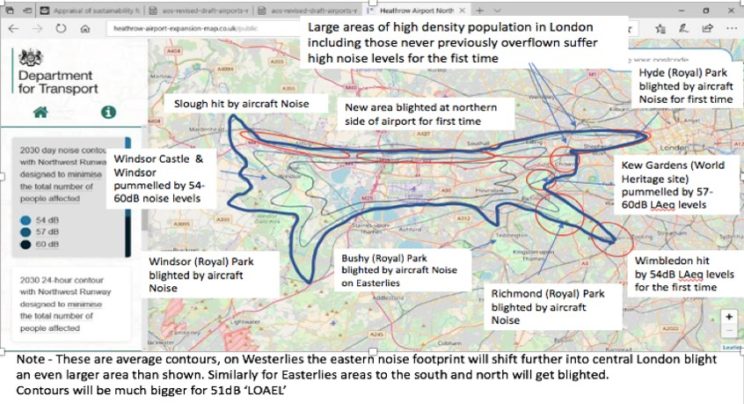Without consultation or proper consideration of the implications, the DfT and CAA have signed an international agreement committing the government to the introduction of PBN in the UK. PBN in aviation involves the use of satellite navigation which will enable an increase in the numbers of air traffic movements and more efficiency, to date using extremely concentrated flight paths. Many areas around Heathrow experienced the trials of PBN in 2014. These were stopped early, following outrage and mass protest from many communities within the airport’s hinterland.
Communities around Gatwick also suffered from the introduction of PBN around the same time but took legal action against the CAA, resulting in an out of court settlement requiring many of the changes being reversed.
Despite mass complaints and protest following early experience of PBN in the UK, the issue hasn’t gone away. The DfT and CAA have sought to pave the way for PBN’s roll out in the UK by overhauling airspace change processes in 2017. At the Transport Select Committee in February 2018 the CAA’s chief executive expressed confidence that in future potential legal challenges can be overcome as a result of these recent changes to the decision-making framework. Communities need to be on their guard. As things stand, whilst the overflown can look forward to being consulted endlessly regarding airspace changes, their legitimate concerns can be overridden without proper political oversight or accountability in the name of overall commercial advantage to aviation, technical limitations and perceived (but unproven) economic benefits.
Teddington Action Group made a presentation to the Heathrow Community Noise Forum on the 16th May 2018.
Here is the text of our presentation:-
Performance Based Navigation (PBN), Flight Paths and Airspace Capacity – A community group’s perspective
Introduction
- This presentation addresses PBN and flight path issues based on TAG’s experience under easterly departures, the 2014 PBN trials and other investigations our group has recently carried out.
- It draws on work undertaken for actions arising from the last CNF meeting on 14 March 2018, particularly concerning international examples of PBN, as well as in relation to projected noise impacts on local communities in relation to the NPS (which was prepared for the Transport Select Committee).
- It culminates in setting out a series of questions which must now be addressed – not just by Heathrow, but especially by the DfT – before airspace modernisation in general and the NPS in particular are considered by MPs.

Anderson Acoustics produced a departure Trials analysis.
The trials in 2014:-
- Only affected areas under departures
- Led to a huge rise in complaints
- Led to public protest meetings from Ascot to Teddington
- The trials were terminated earlier than originally planned
- Most residents believe that noise conditions never returned fully to pre-trial conditions
- The trials led to the establishment of many community groups who now attend the HCNF
This leads to the key question – what can be learned from this experience and how should it influence the shape of things to come?
International experience of concentrated flight paths
It is clear the introduction of highly concentrated routes has led to massive levels of outrage, opposition and protest from affected communities in the USA and Europe.
Examples include;
- In North America – Phoenix, Chicago, Los Angeles, San Francisco, Boston, Charlotte, San Diego, Santa Cruz, Denver, Palo Alto, Baltimore, Des Moines, Seattle and Washington, Toronto, Calgary, and Montreal.
- In the UK and Europe – Brussels, Paris, Notre-Dame Nantes, Munich, Belfast, Edinburgh, Manchester, Gatwick, Heathrow (2014 trials) and London City, in the UK.
For further details – https://www.nextgennoise.org


The Washington Post on 8 March 2018


The Washington Post on 8 March 2018


Legal Challenges are mounting; Phoenix, USA
http://www.azcentral.com/story/news/local/phoenix/2017/03/13/court-hear-phoenix-arguments-against-faa-flight-paths-sky-harbor/98956558/

Legal Challenges are mounting; Montreal, Canada
http://www.cbc.ca/news/canada/montreal/class-action-airplane-noise-1.4614458


Legal Challenges are mounting; Schiphol, Holland
https://nltimes.nl/2018/04/03/local-residents-sue-schiphol-failing-noise-management


Heathrow correctly recognises the PBN issue in its 2016 response to a European airspace modernisation consultation
https://www.easa.europa.eu/sites/default/files/dfu/CRD%202015-01_0.pdf

Why understanding PBN’s impacts and limitations are so important?
- Plans for Heathrow expansion in the NPS only assume ‘Minimise Total’ concentrated flight paths, but based on the trials and international experience the airport and the DfT know this approach will not be acceptable.
- There are evidently practical, technical and acoustic limitations associated with the implementation of PBN – but these have not been widely disclosed or discussed with the public or politicians.
- These limitations include the numbers of alternative flight paths that can be accommodated viably around Heathrow, what physical separation between routes is needed to deliver effective noise relief and the timescale and practicalities for PBN’s full introduction – which could be years away – potentially 2030-35.
- The medical implications of living under concentrated flight paths are not understood – however England’s Chief Medical Officer’s report for 2017 makes it clear that noise is an extremely serious health issue;
‘In terms of the health effects of environmental pollution in Europe, environmental noise comes second in burden of disease to air pollution and arguably is responsible for more disturbance of quality of life. Environmental noise is also responsible for more life years lost than other significant environmental pollutants such as lead, ozone and dioxins.’
The relationship between PBN and Respite
- Respite is concerned with the distribution of noise – spatial and temporal – i.e. flight paths
- Assumptions concerning respite are reflected in how average noise contours and the noise analysis have been modelled in the NPS
- The NPS states that with Heathrow expansion respite will be reduced from one half to one third of the time
- However the health and social impacts of both this and extreme concentration under PBN are not known
- Anderson have produced two interim studies on Respite on behalf of Heathrow
- This work started in 2014 but the research has not yet been concluded
https://www.heathrow.com/noise/making-heathrow-quieter/respite-research
Anderson’s key findings to date in relation to separation of routes and noise impacts
About noise levels – from the sound lab;
- 2-3 dBLAmax difference in successive sounds not particularly noticeable
- 5-6 dBLAmax may be needed for people to tell the difference
- At least 7-8 dBLAmax may be needed to provide a valuable break from noise
About increases and decreases in noise levels;
- Residents are more likely to notice increases in noise than equivalent decreases
- The judged value of respite may or may not be applicable to those newly exposed to aircraft noise
- Public sensitivity in the field may be greater than in the sound lab
These findings are of critical importance to the consideration of PBN and establishing acceptable flight path strategies
Why does this matter so much?
The Transport Select Committee found that if Heathrow is expanded the impacts on neighboring populations by 2030 will be massive;
- 653,900 people will fall within the 54 dBLAeq ‘significantly affected’ contour
- Over half of these, 323,684, will come into this category for the first time
- 419,803 people experiencing above 54 dBLAeq will receive 3 dB increase, equivalent to doubling the number of overflights
- 1,193,227 will be impacted by over 51 dBLAeq , a key new DfT threshold metric (LOEL)
These are minimum figures because;
- They are based on concentrated ‘minimise total’ flight path assumptions
- The noise impacts will be worse immediately after a third runway opens i.e. 2026-2029 – which will be the period of maximum public sensitivity
- The DfT’s new supplementary metrics were omitted from the NPS and its appraisal of sustainability. A far greater number of people would have been shown to be significantly affected, for example using single mode analysis
- The NPS webTAG Noise Workbook indicates that over 2.2 million people will experience increased noise by 2050 (the forecast year) and this will be after the fleet has transitioned to quieter planes. The situation will be far worse in 2030.
This is what Heathrow’s noise contour will look like in 2025

And this is what it will look like in 2030 (even worse in 2028)
This is the ‘best case’ scenario used for the financial modelling of noise annoyance in the NPS ‘Minimise Total Impacted

Key issues that need to be addressed in relation to the introduction of PBN and possible expansion of Heathrow
How many routes can feasibly be flown using PBN in terms of;
- airspace capacity
- technical capability (harmonizing flight management systems)
- safety
- acceptable health and environmental impacts?
What are the implications for London’s airspace strategy arising from the above in terms of;
- consideration and appraisal of alternative flight path scenarios?
- the balance between achieving quality of life for communities and optimising aviation efficiency
- assessment of the environmental and health consequences associated with Heathrow expansion and the NPS and DCO processes?
- the roll out of new flight paths (particularly timing, airspace change procedures and consultations)?
Challenges to Government and the aviation industry
- Very significant impacts to health and quality of life are apparent having regard to UK and international experience of concentrated flight paths (PBN).
- These have an even greater importance than otherwise might be the case given the extent of Heathrow’s exceptionally densely populated hinterland, the projected environmental impacts and especially the proposal to expand Heathrow ATMs by 54%.
- The general public and politicians should be made aware of these issues. How will this be done and how will they to be factored in Parliamentary decision making?
- Given the implications for the huge numbers of people who will be affected, these matters need to be addressed now by Government – before the NPS is considered further – not at some future time.
- It is not satisfactory to say good research is being done and that the industry is looking for solutions, if irreversible far reaching decisions are currently being made. There is no available evidence to suggest that concentrated flight paths can ever lead to acceptable living conditions over residential areas.
- A full and open public debate is required – now!

This is a great article. PBN gives the aviation industry what it wants – certainty about where the aircraft are in the sky – so that ultimately they can get more planes into the same airspace at the same time. It does not work for communities on the ground. The powers that be must appreciate that it isn’t all about how loud an individual aircraft is – it’s also about how many there are.
PBN concentrates the flightpath so that those living directly underneath think that they are now living at the end of the runway. It doesn’t work because those living on either side of the route also hear ALL of the planes – previously with dispersion, those living to one side of the didn’t hear those flying on the other, and v.v.
Luton Airport introduced an RNAV flight path in 2015 on its most frequently flown route, westerly departures heading for European destinations. For those of us underneath – and I am about 18 flight miles from the end of the runway – it’s been a disaster. Complaints went through the roof, even from those on the sides of the track who the airport said would be beneficiaries of the new technology. Over 4 years on, we are still waiting for the CAA to publish the Post Implementation Review.
Excellent document which I have retweeted and posted with addex commented on Facebook. What you present could not be more timely, linked with the Plane Hell Action’s just-published layman’s Study of Camberwell’s Heathrow-maintained noise monitor: https://planehellaction.org.uk/noise-monitor-study/ and the next Consultation.
Many thanks Bridget. It is very good to work with Plane Hell in Action